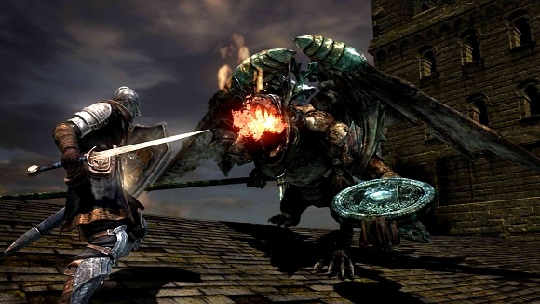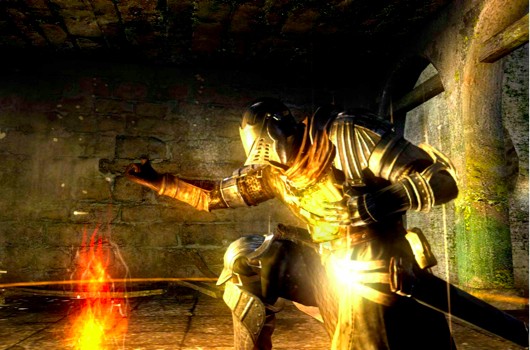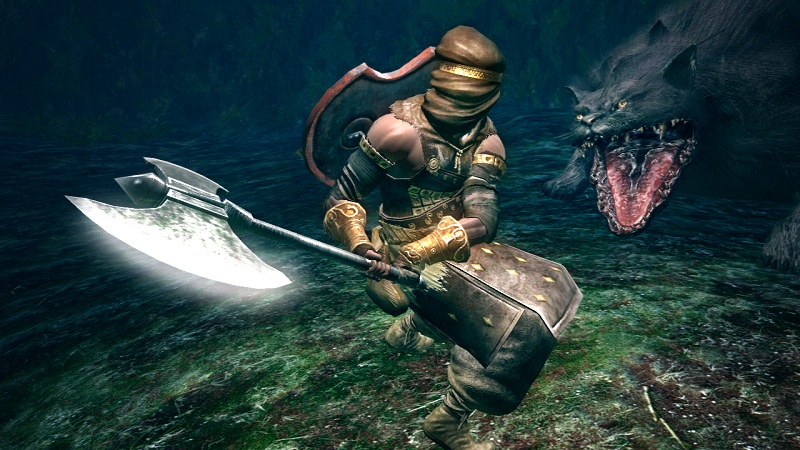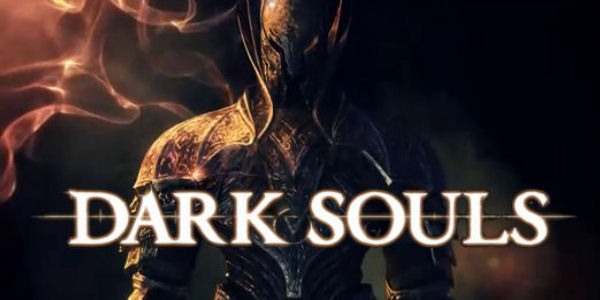 2009’s action RPG Demon’s Souls was a surprise hit that was best known for its brutal difficulty and rewarding combat. Its spiritual successor, Dark Souls, pushes the boundaries even more by ramping up the challenge and intensity. Make no mistake, Dark Souls is hard. Really hard. Then why do I have the urge to keep playing? Is it because it’s addictive? Well, yeah. Is it because it’s rewarding? For sure. Is it because Dark Souls offers a huge, intertwining world of exploration that delivers one of the best embodiments of the action RPG genre? That too. Dark Souls hits the rare mark of perfectly combining elements of both the action and RPG genres that few other games are able to pull off.
2009’s action RPG Demon’s Souls was a surprise hit that was best known for its brutal difficulty and rewarding combat. Its spiritual successor, Dark Souls, pushes the boundaries even more by ramping up the challenge and intensity. Make no mistake, Dark Souls is hard. Really hard. Then why do I have the urge to keep playing? Is it because it’s addictive? Well, yeah. Is it because it’s rewarding? For sure. Is it because Dark Souls offers a huge, intertwining world of exploration that delivers one of the best embodiments of the action RPG genre? That too. Dark Souls hits the rare mark of perfectly combining elements of both the action and RPG genres that few other games are able to pull off.
Dark Souls gives some backstory to the game, but the overall plot isn’t at the forefront of the experience. From what can be pieced together, long ago the world was ruled by dragons. Below the fire of the world there were trapped souls that eventually came into existence as four main beings called the Fire Lords, their leader Lord Gywn, and the human race. The Fire Lords and Lord Gywn were able to rise up and overthrow the dragons and thus saved existence. When the game takes place, all of civilization has been cursed by the Darksign, turning humanity into hollow beings. The gamer controls a hollow whose ultimate goal is to restore the flame of order by going through the various trials in the game. The player must then collect souls from prominent enemies to rise up and restore humanity. The rest of the story can be further explored and put together through well-voiced NPCs and item descriptions. The context for the character’s actions is present if the gamer wants it, but it isn’t prominently driving the game.
The player creates a custom character from a variety of warrior- and mage-type classes, but eventually finds that the character class acts only as a starting point, as there are not restrictions on how a character of any class can be built to suit a player’s preferences. When let out into the world, no explicit direction (other than “up”) is given regarding where to go first, and the complexities of combat aren’t explained in detail. Much like the story, the gamer is expected to figure out these elements of the game without any guidance. While this is somewhat daunting, it’s nice that Dark Souls gives the player options: whether or not to care about the story, what kind of character to build, and how to traverse the world.

Dark Souls plays like an action game. The player’s custom hero uses various medieval weapons and blocks or dodges incoming attacks while strategically maintaining the stamina bar. But what makes it such a good experience is its ability to perfectly blend an action game’s mechanics within an RPG framework. Elements of both genres work in unison and make for a true action-RPG experience. A player with a high-level character is not guaranteed victory without also demonstrating proficiency with the controller, and a low-level character can still be successful in battle on the strength of well-timed attacks, blocks, and evasions. This synergy is also seen in the weapons themselves. Each piece of equipment has a different weight, which players can “feel” through their characters’ speed and agility in the game world, and is also represented numerically as part of the overall equipment burden stat.
Each style of weapon is slightly different, and these differences play into gamers’ combat tactics. For instance, a spear pokes at enemies from behind the cover of a shield, while a sword has a larger radius of swing but will clang against walls. Also, players are able to upgrade and make unique equipment with various souls and collectibles found throughout the world. With stats and upgrades available for each piece of weapon and armor via this crafting system, the RPG aspect of Dark Souls is just as important as its action elements.
Dark Souls received many key upgrades from its predecessor. Unlike Demon’s Souls, there is no longer a central hub that connects branching levels. Instead, Dark Souls provides a huge, open world with many interconnecting areas, alowing the player to decide where to go. It’s always an exciting challenge to find how each area connects to others in order to make traversing the game more manageable. This gives the game a much broader scope and it feels like more of a cohesive world than in Demon’s Souls. It also provides tons of hours of content as exploration is often rewarded with new items, but at the expense of harder enemies. Another addition is the new bonfire system. Bonfires are strategically placed around the world and act as checkpoints that refill the player’s life and potions. However, they also cause all enemies to respawn, emphasizing the challenge of actual play over tedious farming for items to replenish one’s health later on.

One of the most unique aspects of the Souls family of games the online system. Messages from others can be seen throughout players’ game worlds, which exist parallel to one another on the game’s peer-to-peer network, and can offer either helpful tips or dirty tricks. Players can also invade others’ games and be invaded. This gives the game a heavy PvP focus, which is especially appealing to the hardcore player base, and can provide extensive replay value. Online functionalities are emulated during offline solo play, as well. For example, if the gamer’s character is human (certain items can restore an initially undead character’s humanity at bonfires, opening up new gameplay features), a CPU black phantom may invade at random. If defeated, that NPC can be summoned later to help against a boss. There are other instances where the player is able to become a phantom and invade the world of an NPC for a reward. Another new online and offline feature is the covenant system. Players can join any one of the covenants that are littered around the world at any given time, and each has specific benefits and rewards for loyalty. The covenant leader may ask the player to hunt down certain NPCs and other real gamers who belong to different covenants. This system again provides more replay value, as if Dark Souls even needed more. The online functionalities give an already great game even more content and fun.
With all of these additions and well-crafted game mechanics, it may seem that Dark Souls is an enjoyable game to play on the weekends for those looking for some engaging entertainment. Well based on the introduction to this review or having any knowledge of Demon’s Souls, this most assuredly isn’t the case. Dark Souls is as hardcore a game as exists today. It’s punishing at every turn, and with the tagline “Prepare to Die” in huge letters on the back of the box, this should come as no surprise. The game requires much patience and strategy, and sometimes relies too heavily on trial and error. There are times when enemies either burst from a crate or drop from the ceiling that can’t be foreseen. However, this does add to the tension the game puts on players, because at any given moment, death could be right around the corner. For the most part, though, the difficulty isn’t cheap, it’s just globally tuned to a very high “setting.”
Learning enemies’ attack patterns and movements is crucial for success, especially when fighting one of the impressive and intense boss fights the game throws at the player. The boss fights in Dark Souls are nothing short of epic. They range from huge dragons and colossal giants to airborne gargoyles and heavily armored NPCs weilding ludicrous weapons. Each boss is chillingly distinctive and expertly designed, making gamers ponder what kind of mind would come up with this. Even though each enemy gives the player plenty of varied and brutal challenges, the sense of accomplishment is unmatched by any other game this generation. Overcoming the obstacles and enemies in Dark Souls gives the rewarding feeling only a true gamer can describe. However, someone who is not a hardcore gamer will likely be overwhelmed and should shy away from Dark Souls as it does little to try to attract the mainstream audience. For hardcore gamers, though, it doesn’t get much better than this.

Gamers who played Demon’s Souls will see a nice graphical enhancement when they play Dark Souls. The textures and environments look more detailed and crisp, especially seen in the waterlogged environments of New Londo Ruins, as each wall and staircase glistens with liquid. The detail in the environments, like the piles of skeleton bones or torches lighting a small area, gives the world more substance and vitality that either instills dread or signals a glimmer of hope. The open-world environment with no loading times is a great aspect of the game, but it comes at the price of noticeable frame rate drops in heavily populated areas. When in a place like Blighttown, where the player can see the whole town and its many enemies, the frame rate chugs along in a way that is not only bothersome but can be detrimental to the player.
Even though Dark Souls establishes a specific haunting and gothic atmosphere, the many connecting areas of the open world and its enemies are nicely varied from one another. A good example of this is a crystal cave connecting to a dark castle connecting to a cobwebbed spider cavern. The enemies in these areas are appropriate for their surroundings, and each place is distinct enough to remember where they are and how to traverse them time and time again. The music also delivers dark songs that convey a sense of dread throughout the game. The best pieces of music heard are undoubtedly during the boss battles, as they provide some especially frightening and epic melodies, and the notable absence of music in the vast majority of of the world outside these boss arenas reinforces the mood of desolation, while enhancing the rush of the boss encounters.
Dark Souls is not for the mainstream; it’s one of the hardest games this generation, if not the hardest. For those hardcore gamers who want challenge and reward, though, this game is paradise. The combination of action elements with an RPG design makes Dark Souls the true embodiment of the action-RPG. The new open world provides loads of rewarding exploration and choice. Combined with crafting, leveling, and online PvP, this game gives the player hours and hours of content and replay value. While it’s frustrating at times with the drops in frame rate and lack of direction, Dark Souls is a must-own for any hardcore gamer.


















